Case Analysis: Legal and Professional Issues in Nursing Ethics
VerifiedAdded on 2023/04/08
|12
|2613
|315
Case Study
AI Summary
This case study examines the professional misconduct of Ms. Silvia Csepregi, a registered nurse in Australia, whose registration was suspended following an incident involving a 98-year-old patient at the Royal Adelaide Hospital. Ms. Csepregi was found to have engaged in unwarranted physical contact with the patient, causing a bruise, and subsequently falsified a report to cover up the incident. She also attempted to coerce a colleague into corroborating her false account. The analysis delves into the actions and omissions of the nurse that contributed to the adverse outcome, including the failure to proactively identify threatening behaviors, implement suitable interventions, and collaborate effectively with other staff. It further explores alternative actions that could have been taken to prevent the injury, such as assessing the patient's mental state, employing effective communication techniques, and considering the patient's cultural background. Guidelines and measures for managing and preventing violence and aggression in acute old age inpatient settings are also discussed. The case highlights the importance of ethical conduct, accurate record-keeping, and patient safety in nursing practice. Desklib provides similar solved assignments and resources for students.

Legal and Professional Issues in Nursing 1
LEGAL AND PROFESSIONAL ISSUES IN NURSING
Student’s Name
Course
Professor’s Name
University
City
Date
LEGAL AND PROFESSIONAL ISSUES IN NURSING
Student’s Name
Course
Professor’s Name
University
City
Date
Paraphrase This Document
Need a fresh take? Get an instant paraphrase of this document with our AI Paraphraser
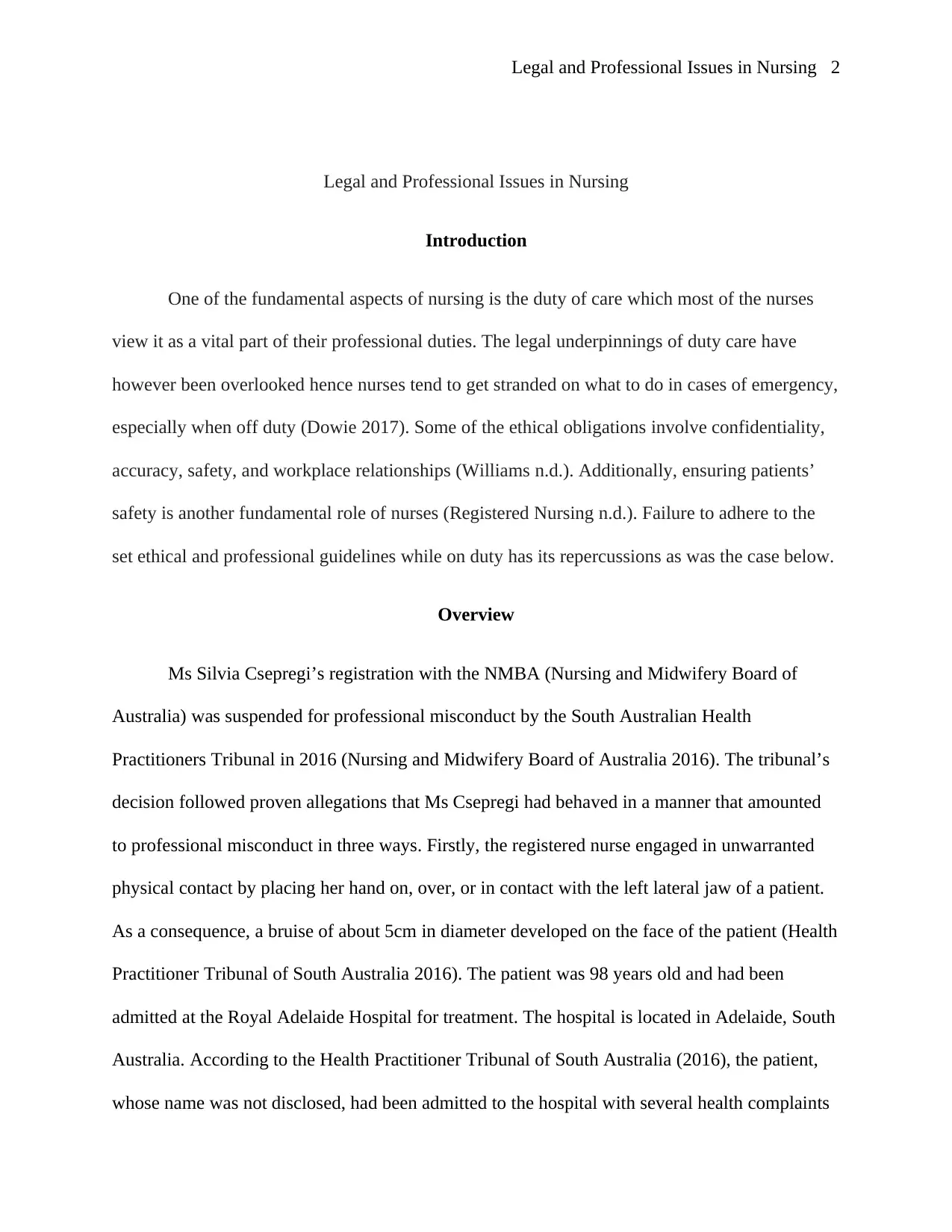
Legal and Professional Issues in Nursing 2
Legal and Professional Issues in Nursing
Introduction
One of the fundamental aspects of nursing is the duty of care which most of the nurses
view it as a vital part of their professional duties. The legal underpinnings of duty care have
however been overlooked hence nurses tend to get stranded on what to do in cases of emergency,
especially when off duty (Dowie 2017). Some of the ethical obligations involve confidentiality,
accuracy, safety, and workplace relationships (Williams n.d.). Additionally, ensuring patients’
safety is another fundamental role of nurses (Registered Nursing n.d.). Failure to adhere to the
set ethical and professional guidelines while on duty has its repercussions as was the case below.
Overview
Ms Silvia Csepregi’s registration with the NMBA (Nursing and Midwifery Board of
Australia) was suspended for professional misconduct by the South Australian Health
Practitioners Tribunal in 2016 (Nursing and Midwifery Board of Australia 2016). The tribunal’s
decision followed proven allegations that Ms Csepregi had behaved in a manner that amounted
to professional misconduct in three ways. Firstly, the registered nurse engaged in unwarranted
physical contact by placing her hand on, over, or in contact with the left lateral jaw of a patient.
As a consequence, a bruise of about 5cm in diameter developed on the face of the patient (Health
Practitioner Tribunal of South Australia 2016). The patient was 98 years old and had been
admitted at the Royal Adelaide Hospital for treatment. The hospital is located in Adelaide, South
Australia. According to the Health Practitioner Tribunal of South Australia (2016), the patient,
whose name was not disclosed, had been admitted to the hospital with several health complaints
Legal and Professional Issues in Nursing
Introduction
One of the fundamental aspects of nursing is the duty of care which most of the nurses
view it as a vital part of their professional duties. The legal underpinnings of duty care have
however been overlooked hence nurses tend to get stranded on what to do in cases of emergency,
especially when off duty (Dowie 2017). Some of the ethical obligations involve confidentiality,
accuracy, safety, and workplace relationships (Williams n.d.). Additionally, ensuring patients’
safety is another fundamental role of nurses (Registered Nursing n.d.). Failure to adhere to the
set ethical and professional guidelines while on duty has its repercussions as was the case below.
Overview
Ms Silvia Csepregi’s registration with the NMBA (Nursing and Midwifery Board of
Australia) was suspended for professional misconduct by the South Australian Health
Practitioners Tribunal in 2016 (Nursing and Midwifery Board of Australia 2016). The tribunal’s
decision followed proven allegations that Ms Csepregi had behaved in a manner that amounted
to professional misconduct in three ways. Firstly, the registered nurse engaged in unwarranted
physical contact by placing her hand on, over, or in contact with the left lateral jaw of a patient.
As a consequence, a bruise of about 5cm in diameter developed on the face of the patient (Health
Practitioner Tribunal of South Australia 2016). The patient was 98 years old and had been
admitted at the Royal Adelaide Hospital for treatment. The hospital is located in Adelaide, South
Australia. According to the Health Practitioner Tribunal of South Australia (2016), the patient,
whose name was not disclosed, had been admitted to the hospital with several health complaints

Legal and Professional Issues in Nursing 3
including a mild cognitive impairment. More precisely, the client was in a vulnerable position
while lacking basic skills of communication.
In addition to causing injury to the patient, another form of professional misconduct
resulted when Ms Csepregi falsified a report in the Safety Learning System database claiming
that the patient’s injury had resulted from accidental contact with her bed railing (Nursing and
Midwifery Board of Australia 2016). What is more, the registered nurse beseeched a colleague to
substantiate the falsified report that she had come up with (Nursing and Midwifery Board of
Australia 2016). After Ms Csepregi owned up the mentioned allegations, the South Australian
Health Practitioners Tribunal established that the nurse’s behavior had resulted to professional
misconduct and that her conduct amounted to a significant departure from appropriate standards
(Health Practitioner Tribunal of South Australia 2016). As a consequence, Ms Csepregi was
reprimanded, her registration was suspended for approximately one year, and certain conditions
were imposed on her registration (Health Practitioner Tribunal of South Australia). These
conditions required the nurse to practice under supervision of a registered nurse and enroll for
further education in the management of cognitive impairment and challenging behaviors, and
nurses’ ethical behavior (Nursing and Midwifery Board of Australia 2016).
Actions Contributing to Causing Bruise on Patient’s Face
As evidenced in the above case, Ms Csepregi’s actions directly contributed to the injury
or bruise on the face of the patient. More precisely, on 3 April 2014, she engaged in unwarranted
physical contact with the patient. She placed her hand on or over the mouth of the patient causing
a bruise around that area. According to Ms Csepregi, her actions were not meant to hurt the
patient. On the contrary, the conduct that led to bruising was aimed at preventing the patient
including a mild cognitive impairment. More precisely, the client was in a vulnerable position
while lacking basic skills of communication.
In addition to causing injury to the patient, another form of professional misconduct
resulted when Ms Csepregi falsified a report in the Safety Learning System database claiming
that the patient’s injury had resulted from accidental contact with her bed railing (Nursing and
Midwifery Board of Australia 2016). What is more, the registered nurse beseeched a colleague to
substantiate the falsified report that she had come up with (Nursing and Midwifery Board of
Australia 2016). After Ms Csepregi owned up the mentioned allegations, the South Australian
Health Practitioners Tribunal established that the nurse’s behavior had resulted to professional
misconduct and that her conduct amounted to a significant departure from appropriate standards
(Health Practitioner Tribunal of South Australia 2016). As a consequence, Ms Csepregi was
reprimanded, her registration was suspended for approximately one year, and certain conditions
were imposed on her registration (Health Practitioner Tribunal of South Australia). These
conditions required the nurse to practice under supervision of a registered nurse and enroll for
further education in the management of cognitive impairment and challenging behaviors, and
nurses’ ethical behavior (Nursing and Midwifery Board of Australia 2016).
Actions Contributing to Causing Bruise on Patient’s Face
As evidenced in the above case, Ms Csepregi’s actions directly contributed to the injury
or bruise on the face of the patient. More precisely, on 3 April 2014, she engaged in unwarranted
physical contact with the patient. She placed her hand on or over the mouth of the patient causing
a bruise around that area. According to Ms Csepregi, her actions were not meant to hurt the
patient. On the contrary, the conduct that led to bruising was aimed at preventing the patient
⊘ This is a preview!⊘
Do you want full access?
Subscribe today to unlock all pages.

Trusted by 1+ million students worldwide
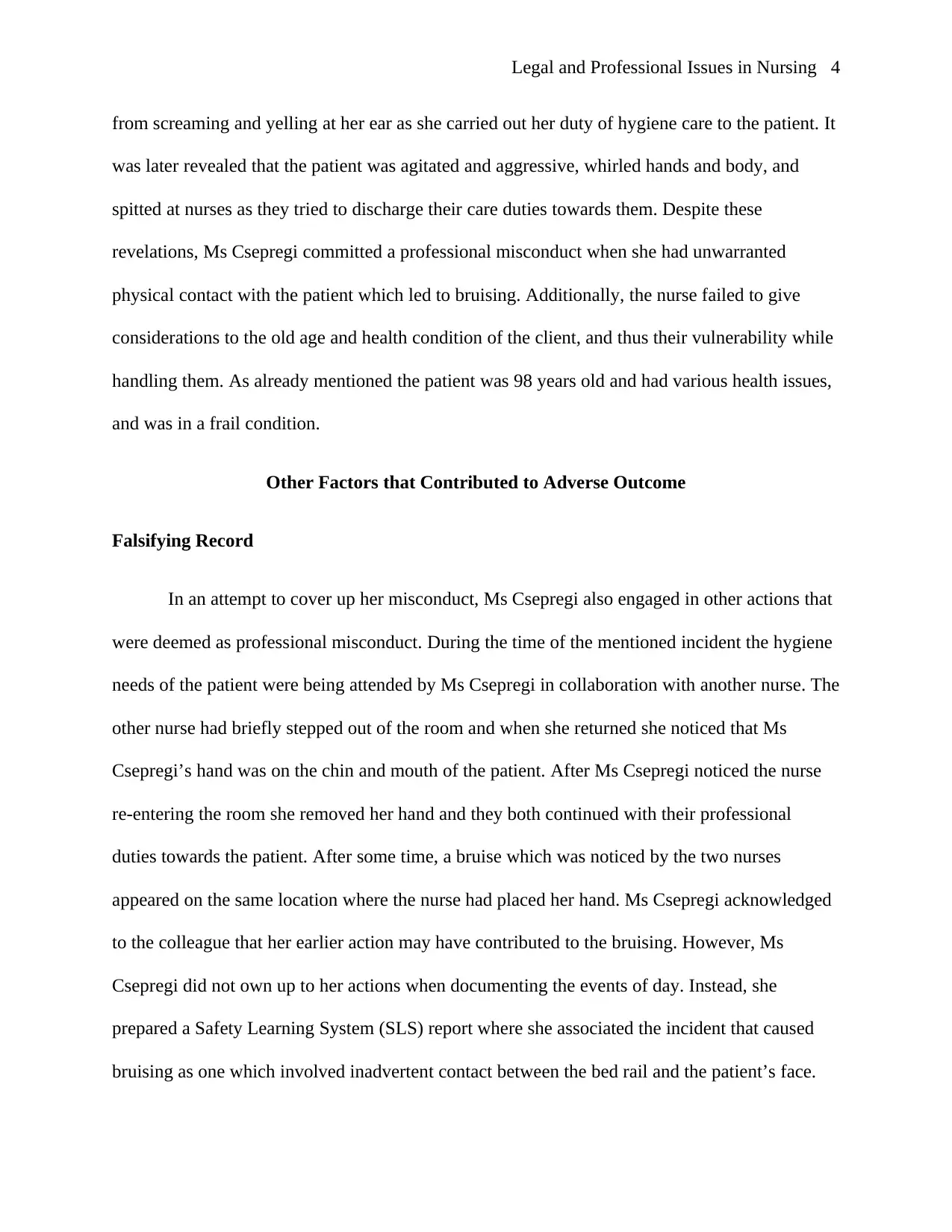
Legal and Professional Issues in Nursing 4
from screaming and yelling at her ear as she carried out her duty of hygiene care to the patient. It
was later revealed that the patient was agitated and aggressive, whirled hands and body, and
spitted at nurses as they tried to discharge their care duties towards them. Despite these
revelations, Ms Csepregi committed a professional misconduct when she had unwarranted
physical contact with the patient which led to bruising. Additionally, the nurse failed to give
considerations to the old age and health condition of the client, and thus their vulnerability while
handling them. As already mentioned the patient was 98 years old and had various health issues,
and was in a frail condition.
Other Factors that Contributed to Adverse Outcome
Falsifying Record
In an attempt to cover up her misconduct, Ms Csepregi also engaged in other actions that
were deemed as professional misconduct. During the time of the mentioned incident the hygiene
needs of the patient were being attended by Ms Csepregi in collaboration with another nurse. The
other nurse had briefly stepped out of the room and when she returned she noticed that Ms
Csepregi’s hand was on the chin and mouth of the patient. After Ms Csepregi noticed the nurse
re-entering the room she removed her hand and they both continued with their professional
duties towards the patient. After some time, a bruise which was noticed by the two nurses
appeared on the same location where the nurse had placed her hand. Ms Csepregi acknowledged
to the colleague that her earlier action may have contributed to the bruising. However, Ms
Csepregi did not own up to her actions when documenting the events of day. Instead, she
prepared a Safety Learning System (SLS) report where she associated the incident that caused
bruising as one which involved inadvertent contact between the bed rail and the patient’s face.
from screaming and yelling at her ear as she carried out her duty of hygiene care to the patient. It
was later revealed that the patient was agitated and aggressive, whirled hands and body, and
spitted at nurses as they tried to discharge their care duties towards them. Despite these
revelations, Ms Csepregi committed a professional misconduct when she had unwarranted
physical contact with the patient which led to bruising. Additionally, the nurse failed to give
considerations to the old age and health condition of the client, and thus their vulnerability while
handling them. As already mentioned the patient was 98 years old and had various health issues,
and was in a frail condition.
Other Factors that Contributed to Adverse Outcome
Falsifying Record
In an attempt to cover up her misconduct, Ms Csepregi also engaged in other actions that
were deemed as professional misconduct. During the time of the mentioned incident the hygiene
needs of the patient were being attended by Ms Csepregi in collaboration with another nurse. The
other nurse had briefly stepped out of the room and when she returned she noticed that Ms
Csepregi’s hand was on the chin and mouth of the patient. After Ms Csepregi noticed the nurse
re-entering the room she removed her hand and they both continued with their professional
duties towards the patient. After some time, a bruise which was noticed by the two nurses
appeared on the same location where the nurse had placed her hand. Ms Csepregi acknowledged
to the colleague that her earlier action may have contributed to the bruising. However, Ms
Csepregi did not own up to her actions when documenting the events of day. Instead, she
prepared a Safety Learning System (SLS) report where she associated the incident that caused
bruising as one which involved inadvertent contact between the bed rail and the patient’s face.
Paraphrase This Document
Need a fresh take? Get an instant paraphrase of this document with our AI Paraphraser
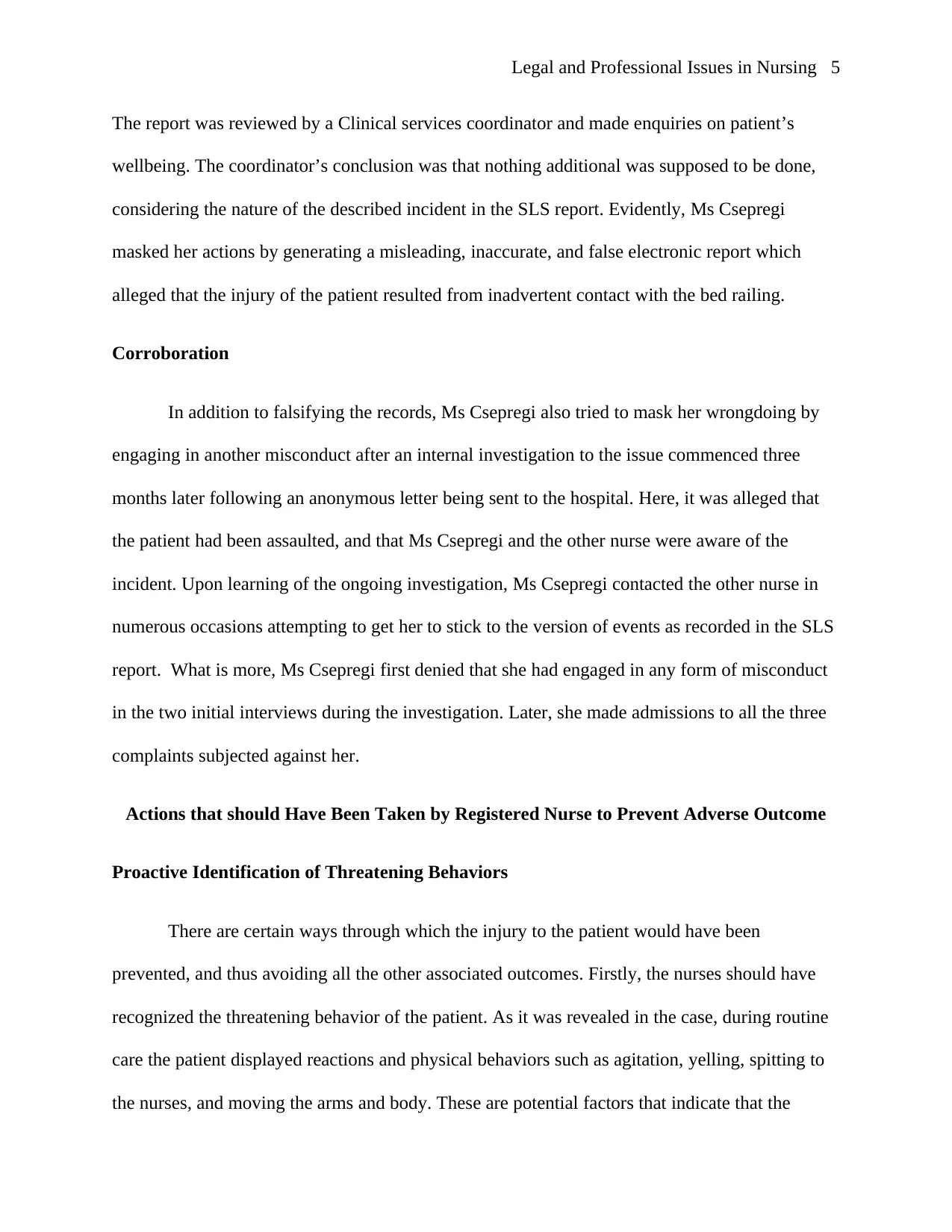
Legal and Professional Issues in Nursing 5
The report was reviewed by a Clinical services coordinator and made enquiries on patient’s
wellbeing. The coordinator’s conclusion was that nothing additional was supposed to be done,
considering the nature of the described incident in the SLS report. Evidently, Ms Csepregi
masked her actions by generating a misleading, inaccurate, and false electronic report which
alleged that the injury of the patient resulted from inadvertent contact with the bed railing.
Corroboration
In addition to falsifying the records, Ms Csepregi also tried to mask her wrongdoing by
engaging in another misconduct after an internal investigation to the issue commenced three
months later following an anonymous letter being sent to the hospital. Here, it was alleged that
the patient had been assaulted, and that Ms Csepregi and the other nurse were aware of the
incident. Upon learning of the ongoing investigation, Ms Csepregi contacted the other nurse in
numerous occasions attempting to get her to stick to the version of events as recorded in the SLS
report. What is more, Ms Csepregi first denied that she had engaged in any form of misconduct
in the two initial interviews during the investigation. Later, she made admissions to all the three
complaints subjected against her.
Actions that should Have Been Taken by Registered Nurse to Prevent Adverse Outcome
Proactive Identification of Threatening Behaviors
There are certain ways through which the injury to the patient would have been
prevented, and thus avoiding all the other associated outcomes. Firstly, the nurses should have
recognized the threatening behavior of the patient. As it was revealed in the case, during routine
care the patient displayed reactions and physical behaviors such as agitation, yelling, spitting to
the nurses, and moving the arms and body. These are potential factors that indicate that the
The report was reviewed by a Clinical services coordinator and made enquiries on patient’s
wellbeing. The coordinator’s conclusion was that nothing additional was supposed to be done,
considering the nature of the described incident in the SLS report. Evidently, Ms Csepregi
masked her actions by generating a misleading, inaccurate, and false electronic report which
alleged that the injury of the patient resulted from inadvertent contact with the bed railing.
Corroboration
In addition to falsifying the records, Ms Csepregi also tried to mask her wrongdoing by
engaging in another misconduct after an internal investigation to the issue commenced three
months later following an anonymous letter being sent to the hospital. Here, it was alleged that
the patient had been assaulted, and that Ms Csepregi and the other nurse were aware of the
incident. Upon learning of the ongoing investigation, Ms Csepregi contacted the other nurse in
numerous occasions attempting to get her to stick to the version of events as recorded in the SLS
report. What is more, Ms Csepregi first denied that she had engaged in any form of misconduct
in the two initial interviews during the investigation. Later, she made admissions to all the three
complaints subjected against her.
Actions that should Have Been Taken by Registered Nurse to Prevent Adverse Outcome
Proactive Identification of Threatening Behaviors
There are certain ways through which the injury to the patient would have been
prevented, and thus avoiding all the other associated outcomes. Firstly, the nurses should have
recognized the threatening behavior of the patient. As it was revealed in the case, during routine
care the patient displayed reactions and physical behaviors such as agitation, yelling, spitting to
the nurses, and moving the arms and body. These are potential factors that indicate that the
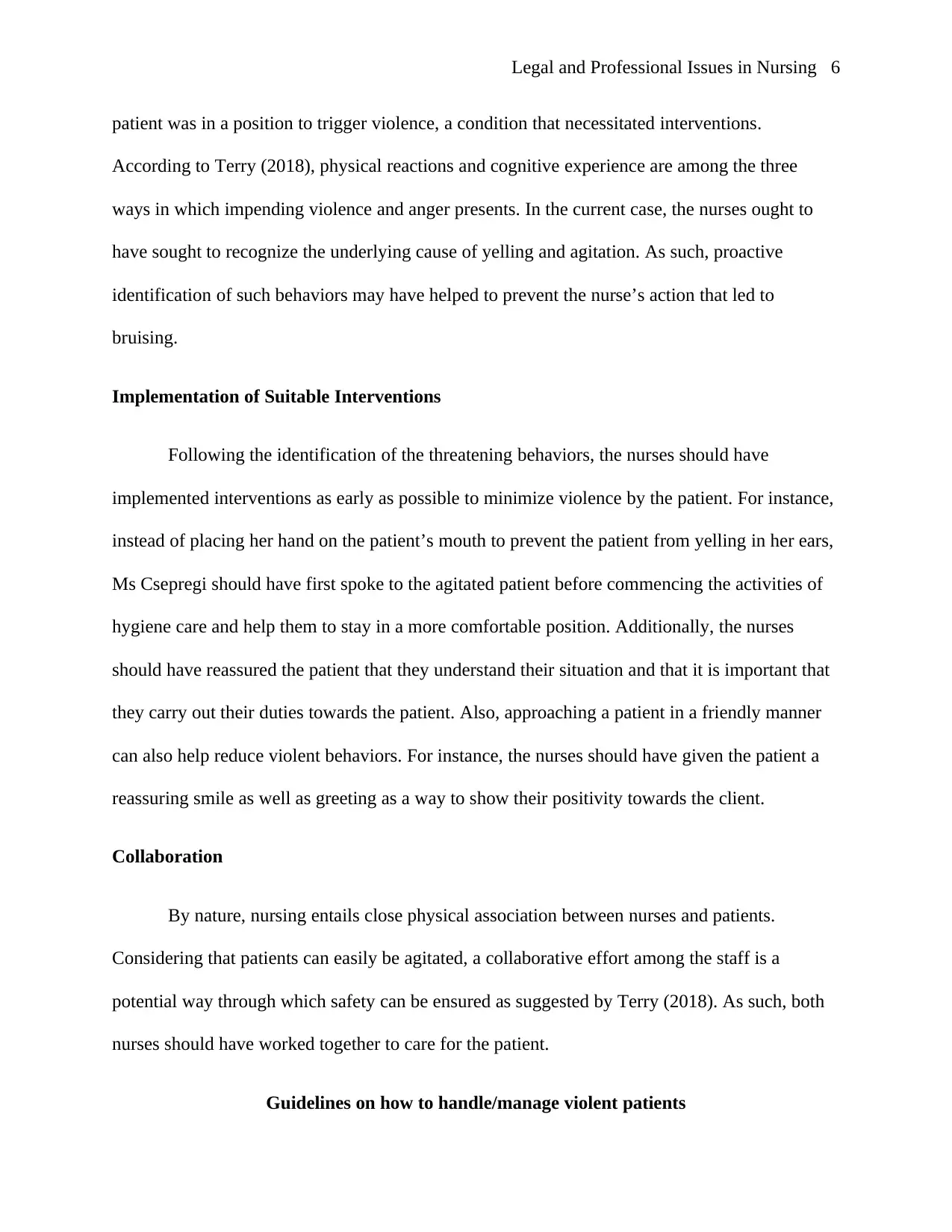
Legal and Professional Issues in Nursing 6
patient was in a position to trigger violence, a condition that necessitated interventions.
According to Terry (2018), physical reactions and cognitive experience are among the three
ways in which impending violence and anger presents. In the current case, the nurses ought to
have sought to recognize the underlying cause of yelling and agitation. As such, proactive
identification of such behaviors may have helped to prevent the nurse’s action that led to
bruising.
Implementation of Suitable Interventions
Following the identification of the threatening behaviors, the nurses should have
implemented interventions as early as possible to minimize violence by the patient. For instance,
instead of placing her hand on the patient’s mouth to prevent the patient from yelling in her ears,
Ms Csepregi should have first spoke to the agitated patient before commencing the activities of
hygiene care and help them to stay in a more comfortable position. Additionally, the nurses
should have reassured the patient that they understand their situation and that it is important that
they carry out their duties towards the patient. Also, approaching a patient in a friendly manner
can also help reduce violent behaviors. For instance, the nurses should have given the patient a
reassuring smile as well as greeting as a way to show their positivity towards the client.
Collaboration
By nature, nursing entails close physical association between nurses and patients.
Considering that patients can easily be agitated, a collaborative effort among the staff is a
potential way through which safety can be ensured as suggested by Terry (2018). As such, both
nurses should have worked together to care for the patient.
Guidelines on how to handle/manage violent patients
patient was in a position to trigger violence, a condition that necessitated interventions.
According to Terry (2018), physical reactions and cognitive experience are among the three
ways in which impending violence and anger presents. In the current case, the nurses ought to
have sought to recognize the underlying cause of yelling and agitation. As such, proactive
identification of such behaviors may have helped to prevent the nurse’s action that led to
bruising.
Implementation of Suitable Interventions
Following the identification of the threatening behaviors, the nurses should have
implemented interventions as early as possible to minimize violence by the patient. For instance,
instead of placing her hand on the patient’s mouth to prevent the patient from yelling in her ears,
Ms Csepregi should have first spoke to the agitated patient before commencing the activities of
hygiene care and help them to stay in a more comfortable position. Additionally, the nurses
should have reassured the patient that they understand their situation and that it is important that
they carry out their duties towards the patient. Also, approaching a patient in a friendly manner
can also help reduce violent behaviors. For instance, the nurses should have given the patient a
reassuring smile as well as greeting as a way to show their positivity towards the client.
Collaboration
By nature, nursing entails close physical association between nurses and patients.
Considering that patients can easily be agitated, a collaborative effort among the staff is a
potential way through which safety can be ensured as suggested by Terry (2018). As such, both
nurses should have worked together to care for the patient.
Guidelines on how to handle/manage violent patients
⊘ This is a preview!⊘
Do you want full access?
Subscribe today to unlock all pages.

Trusted by 1+ million students worldwide
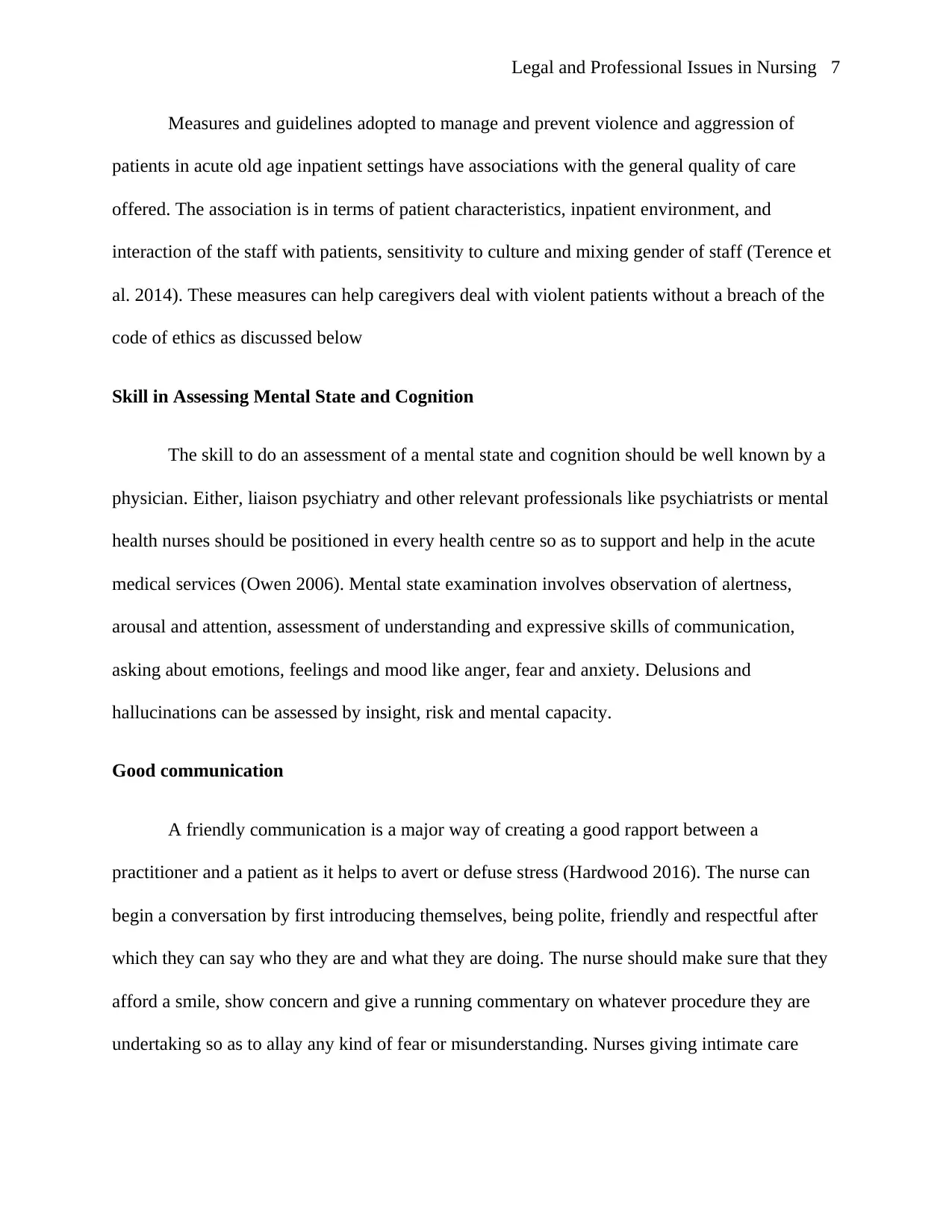
Legal and Professional Issues in Nursing 7
Measures and guidelines adopted to manage and prevent violence and aggression of
patients in acute old age inpatient settings have associations with the general quality of care
offered. The association is in terms of patient characteristics, inpatient environment, and
interaction of the staff with patients, sensitivity to culture and mixing gender of staff (Terence et
al. 2014). These measures can help caregivers deal with violent patients without a breach of the
code of ethics as discussed below
Skill in Assessing Mental State and Cognition
The skill to do an assessment of a mental state and cognition should be well known by a
physician. Either, liaison psychiatry and other relevant professionals like psychiatrists or mental
health nurses should be positioned in every health centre so as to support and help in the acute
medical services (Owen 2006). Mental state examination involves observation of alertness,
arousal and attention, assessment of understanding and expressive skills of communication,
asking about emotions, feelings and mood like anger, fear and anxiety. Delusions and
hallucinations can be assessed by insight, risk and mental capacity.
Good communication
A friendly communication is a major way of creating a good rapport between a
practitioner and a patient as it helps to avert or defuse stress (Hardwood 2016). The nurse can
begin a conversation by first introducing themselves, being polite, friendly and respectful after
which they can say who they are and what they are doing. The nurse should make sure that they
afford a smile, show concern and give a running commentary on whatever procedure they are
undertaking so as to allay any kind of fear or misunderstanding. Nurses giving intimate care
Measures and guidelines adopted to manage and prevent violence and aggression of
patients in acute old age inpatient settings have associations with the general quality of care
offered. The association is in terms of patient characteristics, inpatient environment, and
interaction of the staff with patients, sensitivity to culture and mixing gender of staff (Terence et
al. 2014). These measures can help caregivers deal with violent patients without a breach of the
code of ethics as discussed below
Skill in Assessing Mental State and Cognition
The skill to do an assessment of a mental state and cognition should be well known by a
physician. Either, liaison psychiatry and other relevant professionals like psychiatrists or mental
health nurses should be positioned in every health centre so as to support and help in the acute
medical services (Owen 2006). Mental state examination involves observation of alertness,
arousal and attention, assessment of understanding and expressive skills of communication,
asking about emotions, feelings and mood like anger, fear and anxiety. Delusions and
hallucinations can be assessed by insight, risk and mental capacity.
Good communication
A friendly communication is a major way of creating a good rapport between a
practitioner and a patient as it helps to avert or defuse stress (Hardwood 2016). The nurse can
begin a conversation by first introducing themselves, being polite, friendly and respectful after
which they can say who they are and what they are doing. The nurse should make sure that they
afford a smile, show concern and give a running commentary on whatever procedure they are
undertaking so as to allay any kind of fear or misunderstanding. Nurses giving intimate care
Paraphrase This Document
Need a fresh take? Get an instant paraphrase of this document with our AI Paraphraser

Legal and Professional Issues in Nursing 8
should refrain from confronting, contradicting, embarrassing or humiliating under any
circumstances.
Pharmacological Management
In some cases, sedation may be advisable especially in extreme instances. The drug and
dosage used depends on the age and size of the patient, other drugs taken and known illness. An
oral sedative is offered to disturbed patients in the first instance in a non-threatening
collaborative way. Parenteral sedation can also be adopted though it requires several trained staff
to convince the patient or restrain the patient while administering the medication. Sedation will
help calm the patient down in cases of extreme violence (Fulde and Preisz 2011).
Understanding the Patient’s Cultural Background
Taking a patient’s cultural background into account is mandatory especially when
formulating diagnosis and care plans (Queensland Mind Essentials 2016). This is because one’s
cultural background can greatly influence how symptoms of mental illness are understood or
expressed.
Physical Restraint
In case of an escalated patient’s behavior, it is upon the nurse in charge to notify the
NUM/In-charge as well as the ICU team. It is then upon the team to order the restraint in
accordance with the SESLHD PD so as to prevent the patient from harming herself and others
(Sutherland Hospitals and Health Services 2014). The observations of the skin and restraints
must be attended and documented at intervals of 15 minutes as per SESLHD PD 111. Besides
physical restraints, security should also conduct a thorough search for the presence of weapons
should refrain from confronting, contradicting, embarrassing or humiliating under any
circumstances.
Pharmacological Management
In some cases, sedation may be advisable especially in extreme instances. The drug and
dosage used depends on the age and size of the patient, other drugs taken and known illness. An
oral sedative is offered to disturbed patients in the first instance in a non-threatening
collaborative way. Parenteral sedation can also be adopted though it requires several trained staff
to convince the patient or restrain the patient while administering the medication. Sedation will
help calm the patient down in cases of extreme violence (Fulde and Preisz 2011).
Understanding the Patient’s Cultural Background
Taking a patient’s cultural background into account is mandatory especially when
formulating diagnosis and care plans (Queensland Mind Essentials 2016). This is because one’s
cultural background can greatly influence how symptoms of mental illness are understood or
expressed.
Physical Restraint
In case of an escalated patient’s behavior, it is upon the nurse in charge to notify the
NUM/In-charge as well as the ICU team. It is then upon the team to order the restraint in
accordance with the SESLHD PD so as to prevent the patient from harming herself and others
(Sutherland Hospitals and Health Services 2014). The observations of the skin and restraints
must be attended and documented at intervals of 15 minutes as per SESLHD PD 111. Besides
physical restraints, security should also conduct a thorough search for the presence of weapons

Legal and Professional Issues in Nursing 9
and objects that can cause harm to the patient and nurse, confiscate them and then notify the
police concerning the same.
Conclusion
In conclusion, the number of nurses associated with malpractice lawsuits has been
escalating with time (Croke 2003). Sadly, experts in patient safety at John Hopkins claim that
over 250,000 deaths occur annually in the U.S due to medical errors (Sorrell 2017). Most of the
patients get harmed in the course of their health care resulting in permanent injury or death
(World Health Organization n.d.), like in the case of our patient A. However, the severity of
these health care errors can be reduced by sustained and collaborative efforts of the relevant
personnel (Zane et al. 2008). Considering the varied characters of people placed in correctional
health care, the nursing team and correctional officers should work together closely so as to
manage all emergency situations in patients as well as ensure the security of the health
professionals (Australian Primary Health Care Nurses Association 2017). Also, nurses should
recognize that licensing of registered nurses is a symbol of trust by both the healthcare system
and the public for the professionals to practice with integrity as stated by Porter (2013).
and objects that can cause harm to the patient and nurse, confiscate them and then notify the
police concerning the same.
Conclusion
In conclusion, the number of nurses associated with malpractice lawsuits has been
escalating with time (Croke 2003). Sadly, experts in patient safety at John Hopkins claim that
over 250,000 deaths occur annually in the U.S due to medical errors (Sorrell 2017). Most of the
patients get harmed in the course of their health care resulting in permanent injury or death
(World Health Organization n.d.), like in the case of our patient A. However, the severity of
these health care errors can be reduced by sustained and collaborative efforts of the relevant
personnel (Zane et al. 2008). Considering the varied characters of people placed in correctional
health care, the nursing team and correctional officers should work together closely so as to
manage all emergency situations in patients as well as ensure the security of the health
professionals (Australian Primary Health Care Nurses Association 2017). Also, nurses should
recognize that licensing of registered nurses is a symbol of trust by both the healthcare system
and the public for the professionals to practice with integrity as stated by Porter (2013).
⊘ This is a preview!⊘
Do you want full access?
Subscribe today to unlock all pages.

Trusted by 1+ million students worldwide

Legal and Professional Issues in Nursing 10
Reference List
Croke, E (2003), Nurses, negligence, and malpractice. Available from:
<https://www.nursingcenter.com/journalarticle?
Article_ID=423284&Journal_ID=54030&Issue_ID=423107>[20 March 2019].
Dowie, I (2017), ‘Legal, ethical and professional aspects of duty of care for nurses', Nursing
Standard, vol. 13, no. 32, pp.47-52.
Fulde, G & Preisz , P (2011), ‘Managing aggressive and violent patients’. Australian Prescriber,
vol. 11, no. 34, pp. 166-168.
Hardwood, RH (2016), ‘How to deal with violent and aggressive patients in acute medical
settings’. Royal College of Physicians of Edinburgh, vol.47, pp. 176-182.
Health Practitioner Tribunal of South Australia (2016), Nursing and midwifery board of
Australia v Csepregi [2016] SAHPT. Available from
<http://www.healthpractitionerstribunal.sa.gov.au/download.cfm?downloadfile=836EFE80-
32CE-11E6-8B78020054554E01&typename=dmFile&fieldname=filename>[20 March 2019].
Nursing and Midwifery Board of Australia (2016), Tribunal suspends nurse for professional
misconduct and falsifying report. Available from
<https://www.nursingmidwiferyboard.gov.au/News/2016-06-17-registration-suspended.aspx>[20
March 2019].
Owen, PW (2006), Guidelines: the management of disturbed/violent behavior in inpatient
psychiatric settings. Available from
Reference List
Croke, E (2003), Nurses, negligence, and malpractice. Available from:
<https://www.nursingcenter.com/journalarticle?
Article_ID=423284&Journal_ID=54030&Issue_ID=423107>[20 March 2019].
Dowie, I (2017), ‘Legal, ethical and professional aspects of duty of care for nurses', Nursing
Standard, vol. 13, no. 32, pp.47-52.
Fulde, G & Preisz , P (2011), ‘Managing aggressive and violent patients’. Australian Prescriber,
vol. 11, no. 34, pp. 166-168.
Hardwood, RH (2016), ‘How to deal with violent and aggressive patients in acute medical
settings’. Royal College of Physicians of Edinburgh, vol.47, pp. 176-182.
Health Practitioner Tribunal of South Australia (2016), Nursing and midwifery board of
Australia v Csepregi [2016] SAHPT. Available from
<http://www.healthpractitionerstribunal.sa.gov.au/download.cfm?downloadfile=836EFE80-
32CE-11E6-8B78020054554E01&typename=dmFile&fieldname=filename>[20 March 2019].
Nursing and Midwifery Board of Australia (2016), Tribunal suspends nurse for professional
misconduct and falsifying report. Available from
<https://www.nursingmidwiferyboard.gov.au/News/2016-06-17-registration-suspended.aspx>[20
March 2019].
Owen, PW (2006), Guidelines: the management of disturbed/violent behavior in inpatient
psychiatric settings. Available from
Paraphrase This Document
Need a fresh take? Get an instant paraphrase of this document with our AI Paraphraser
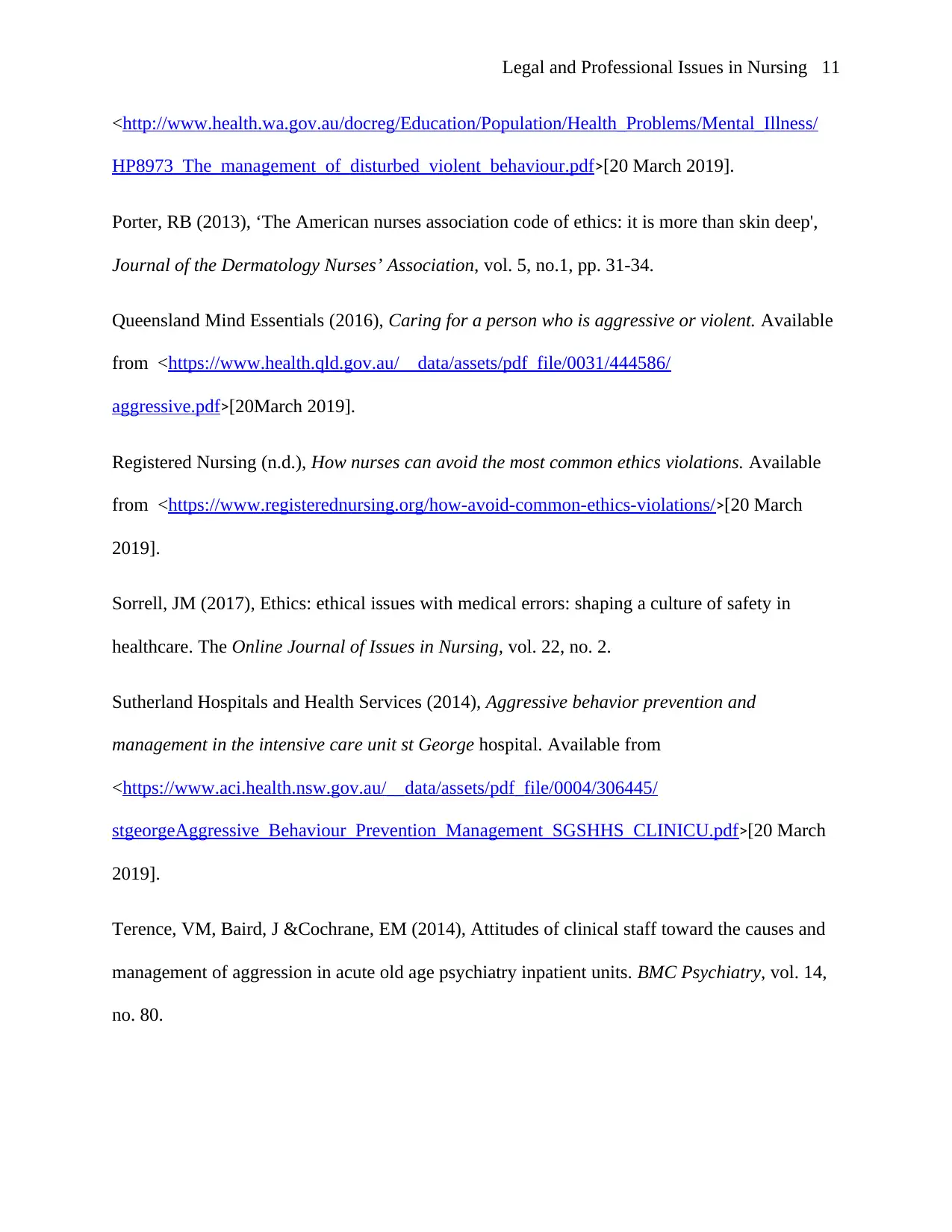
Legal and Professional Issues in Nursing 11
<http://www.health.wa.gov.au/docreg/Education/Population/Health_Problems/Mental_Illness/
HP8973_The_management_of_disturbed_violent_behaviour.pdf>[20 March 2019].
Porter, RB (2013), ‘The American nurses association code of ethics: it is more than skin deep',
Journal of the Dermatology Nurses’ Association, vol. 5, no.1, pp. 31-34.
Queensland Mind Essentials (2016), Caring for a person who is aggressive or violent. Available
from <https://www.health.qld.gov.au/__data/assets/pdf_file/0031/444586/
aggressive.pdf>[20March 2019].
Registered Nursing (n.d.), How nurses can avoid the most common ethics violations. Available
from <https://www.registerednursing.org/how-avoid-common-ethics-violations/>[20 March
2019].
Sorrell, JM (2017), Ethics: ethical issues with medical errors: shaping a culture of safety in
healthcare. The Online Journal of Issues in Nursing, vol. 22, no. 2.
Sutherland Hospitals and Health Services (2014), Aggressive behavior prevention and
management in the intensive care unit st George hospital. Available from
<https://www.aci.health.nsw.gov.au/__data/assets/pdf_file/0004/306445/
stgeorgeAggressive_Behaviour_Prevention_Management_SGSHHS_CLINICU.pdf>[20 March
2019].
Terence, VM, Baird, J &Cochrane, EM (2014), Attitudes of clinical staff toward the causes and
management of aggression in acute old age psychiatry inpatient units. BMC Psychiatry, vol. 14,
no. 80.
<http://www.health.wa.gov.au/docreg/Education/Population/Health_Problems/Mental_Illness/
HP8973_The_management_of_disturbed_violent_behaviour.pdf>[20 March 2019].
Porter, RB (2013), ‘The American nurses association code of ethics: it is more than skin deep',
Journal of the Dermatology Nurses’ Association, vol. 5, no.1, pp. 31-34.
Queensland Mind Essentials (2016), Caring for a person who is aggressive or violent. Available
from <https://www.health.qld.gov.au/__data/assets/pdf_file/0031/444586/
aggressive.pdf>[20March 2019].
Registered Nursing (n.d.), How nurses can avoid the most common ethics violations. Available
from <https://www.registerednursing.org/how-avoid-common-ethics-violations/>[20 March
2019].
Sorrell, JM (2017), Ethics: ethical issues with medical errors: shaping a culture of safety in
healthcare. The Online Journal of Issues in Nursing, vol. 22, no. 2.
Sutherland Hospitals and Health Services (2014), Aggressive behavior prevention and
management in the intensive care unit st George hospital. Available from
<https://www.aci.health.nsw.gov.au/__data/assets/pdf_file/0004/306445/
stgeorgeAggressive_Behaviour_Prevention_Management_SGSHHS_CLINICU.pdf>[20 March
2019].
Terence, VM, Baird, J &Cochrane, EM (2014), Attitudes of clinical staff toward the causes and
management of aggression in acute old age psychiatry inpatient units. BMC Psychiatry, vol. 14,
no. 80.
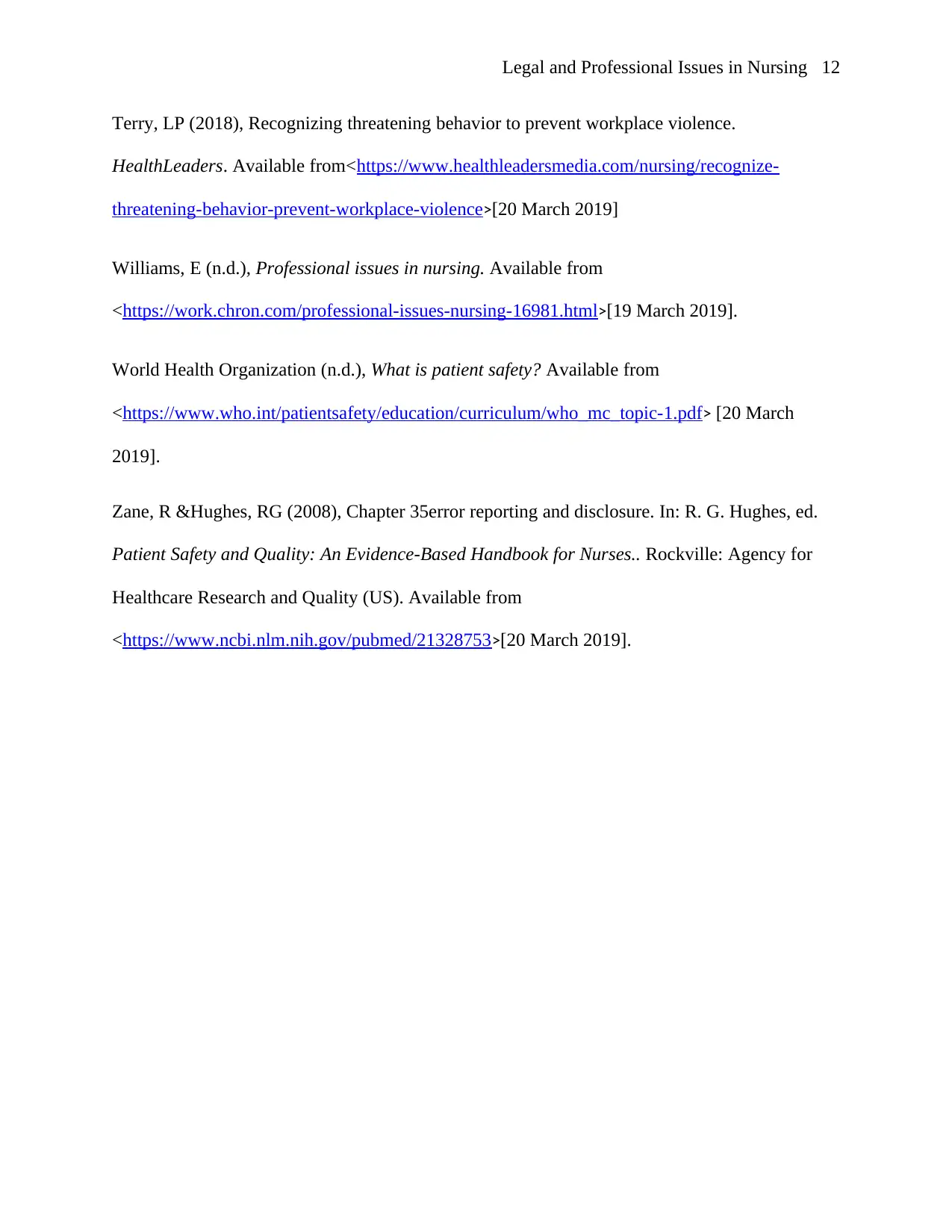
Legal and Professional Issues in Nursing 12
Terry, LP (2018), Recognizing threatening behavior to prevent workplace violence.
HealthLeaders. Available from<https://www.healthleadersmedia.com/nursing/recognize-
threatening-behavior-prevent-workplace-violence>[20 March 2019]
Williams, E (n.d.), Professional issues in nursing. Available from
<https://work.chron.com/professional-issues-nursing-16981.html>[19 March 2019].
World Health Organization (n.d.), What is patient safety? Available from
<https://www.who.int/patientsafety/education/curriculum/who_mc_topic-1.pdf> [20 March
2019].
Zane, R &Hughes, RG (2008), Chapter 35error reporting and disclosure. In: R. G. Hughes, ed.
Patient Safety and Quality: An Evidence-Based Handbook for Nurses.. Rockville: Agency for
Healthcare Research and Quality (US). Available from
<https://www.ncbi.nlm.nih.gov/pubmed/21328753>[20 March 2019].
Terry, LP (2018), Recognizing threatening behavior to prevent workplace violence.
HealthLeaders. Available from<https://www.healthleadersmedia.com/nursing/recognize-
threatening-behavior-prevent-workplace-violence>[20 March 2019]
Williams, E (n.d.), Professional issues in nursing. Available from
<https://work.chron.com/professional-issues-nursing-16981.html>[19 March 2019].
World Health Organization (n.d.), What is patient safety? Available from
<https://www.who.int/patientsafety/education/curriculum/who_mc_topic-1.pdf> [20 March
2019].
Zane, R &Hughes, RG (2008), Chapter 35error reporting and disclosure. In: R. G. Hughes, ed.
Patient Safety and Quality: An Evidence-Based Handbook for Nurses.. Rockville: Agency for
Healthcare Research and Quality (US). Available from
<https://www.ncbi.nlm.nih.gov/pubmed/21328753>[20 March 2019].
⊘ This is a preview!⊘
Do you want full access?
Subscribe today to unlock all pages.

Trusted by 1+ million students worldwide
1 out of 12
Related Documents
Your All-in-One AI-Powered Toolkit for Academic Success.
+13062052269
info@desklib.com
Available 24*7 on WhatsApp / Email
![[object Object]](/_next/static/media/star-bottom.7253800d.svg)
Unlock your academic potential
Copyright © 2020–2025 A2Z Services. All Rights Reserved. Developed and managed by ZUCOL.





